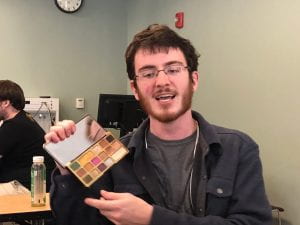Rules
- 4-5 players: One running the game (GM), the rest playing
- Materials: 5 random cosmetic products, which the GM keeps secret until each one is necessary
- Concept/Goal: Play as a social media beauty influencer and try to advertise a sponsored product the best, using trends and insecurities to win over the “audience” (the GM), who decides whose sell was the best.
- For prompts, players can use any of the following social media types/personas, but it is not required to stick to one
- Tutorial; review; prank; vlog; storytime; skit; etc
- Doesn’t necessarily have to be a “video” format
- Rules
- For each round, the GM picks one thing from a list of “insecurities” or can make up their own. They can elaborate on it as much as they want, and make it anywhere between realistic and absurd. These are trends in the hypothetical beauty audience that the players should take advantage of. (List below)
- The GM then reveals a product from the bag. This is what the players must sell.
- The insecurity and product DO NOT need to be related; in fact, it is more interesting if they are not.
- Players can go in any order and can argue and play off of each other, but whoever is speaking MUST be holding the product
- Players can go for
- It is up to the GM’s discretion how they judge the players, and who wins. For the rest of the game, the winner of a round holds onto the product as their “point”
- Insecurities
- Pore size
- Acne
- Skintone
- Facial hair
- Hairstyles
- Hair hygiene
- Body size
Artist Statement
I’ve always had a lot of opinions about makeup and the culture around it, and those opinions are frequently shifting. Recently, I’ve been thinking a lot about the popularity of influencers and beauty gurus on social media and how they market products to consumers in a more subtle way than traditional advertising. These people portray themselves as friends of their audiences, leading to strong parasocial relationship that can then be exploited; they’re called “influencers” for a reason. I respect their careers, but as a frequent consumer of their content it’s important to remain critical and mindful.
In this piece, I’m appropriating both the physical makeup objects as well as the culture and behaviors of online makeup communities. The interactions between players in the game simulate and parody the more long-term interactions of social media influencers, done over comments and replies and my personal favorite, the “response” video. Influencers are known for their dramatics and the constant feuds and callouts; recently, many have been called out for racist behavior, resulting in video after video of bad apologies and people getting angry. It’s escalated to the point of some social media personalities creating entire Youtube documentary series about a particular issue, fanning the flames as well as perpetuating the drama for entertainment. Not only are they marketing products to us, they’re also marketing that this kind of behavior is okay, and that this is the correct way to deal with it. They make reality television more personal just as they do with marketing.
I was inspired quite a bit by the themes of consumerism in the Dada and Fluxus movements, and thought a lot about how they tried to separate art and artists from their associations as precious, valuable things and people (moreso than others), to no avail. It reminds me of the celebrity reputations of social media stars and how, even if they don’t want to, they must often sell their popularity for a living. I was also inspired by the readymades of the Dada era, especially those of Duchamp, and how they take an object and, by turning it into an art object, render it useless in the original regard. In my game, the makeup products become objects, and it is up to the players to decide what its use is, whether it’s true to reality or absolutely absurd. The point of the game isn’t the makeup, it’s what the players do with it, and how it makes them interact with each other. The original idea for using makeup objects as pieces also came from Takako Saito’s Fluxus chess pieces.
Originally, the game had players take turns, speaking one at a time. However, once playtested, the players began talking over each other and directly responding and arguing with one another. I found this tied into the themes even better and was also more entertaining, so I changed the rules to encourage it.


